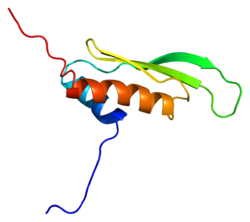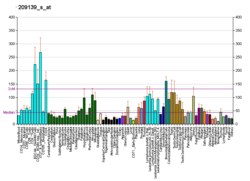PRKRA
Protein kinase, interferon-inducible double stranded RNA dependent activator, also known as interferon-inducible double stranded RNA-dependent protein kinase activator A or Protein ACTivator of the interferon-induced protein kinase (PACT) is a protein that in humans is encoded by the PRKRA gene.[5][6][7] PACT heterodimerizes with and activates protein kinase R.[6][8] PRKRA mutations have been linked to a rare form of dystonia parkinsonism.[9]
References
[edit]- ^ a b c GRCh38: Ensembl release 89: ENSG00000180228 – Ensembl, May 2017
- ^ a b c GRCm38: Ensembl release 89: ENSMUSG00000002731 – Ensembl, May 2017
- ^ "Human PubMed Reference:". National Center for Biotechnology Information, U.S. National Library of Medicine.
- ^ "Mouse PubMed Reference:". National Center for Biotechnology Information, U.S. National Library of Medicine.
- ^ "Entrez Gene: PRKRA protein kinase, interferon-inducible double stranded RNA dependent activator".
- ^ a b Patel RC, Sen GC (August 1998). "PACT, a protein activator of the interferon-induced protein kinase, PKR". EMBO J. 17 (15): 4379–90. doi:10.1093/emboj/17.15.4379. PMC 1170771. PMID 9687506.
- ^ Ito T, Yang M, May WS (May 1999). "RAX, a cellular activator for double-stranded RNA-dependent protein kinase during stress signaling". J. Biol. Chem. 274 (22): 15427–32. doi:10.1074/jbc.274.22.15427. PMID 10336432.
- ^ Huang X, Hutchins B, Patel RC (August 2002). "The C-terminal, third conserved motif of the protein activator PACT plays an essential role in the activation of double-stranded-RNA-dependent protein kinase (PKR)". Biochem. J. 366 (Pt 1): 175–86. doi:10.1042/BJ20020204. PMC 1222748. PMID 11985496.
- ^ Camargos S, Scholz S, Simón-Sánchez J, Paisán-Ruiz C, Lewis P, Hernandez D, Ding J, Gibbs JR, Cookson MR, Bras J, Guerreiro R, Oliveira CR, Lees A, Hardy J, Cardoso F, Singleton AB (March 2008). "DYT16, a novel young-onset dystonia-parkinsonism disorder: identification of a segregating mutation in the stress-response protein PRKRA". Lancet Neurology. 7 (3): 207–215. doi:10.1016/S1474-4422(08)70022-X. PMID 18243799. S2CID 206157913.
Further reading
[edit]- Maruyama K, Sugano S (1994). "Oligo-capping: a simple method to replace the cap structure of eukaryotic mRNAs with oligoribonucleotides". Gene. 138 (1–2): 171–4. doi:10.1016/0378-1119(94)90802-8. PMID 8125298.
- Suzuki Y, Yoshitomo-Nakagawa K, Maruyama K, et al. (1997). "Construction and characterization of a full length-enriched and a 5'-end-enriched cDNA library". Gene. 200 (1–2): 149–56. doi:10.1016/S0378-1119(97)00411-3. PMID 9373149.
- Peters GA, Hartmann R, Qin J, et al. (2001). "Modular structure of PACT: distinct domains for binding and activating PKR". Mol Cell Biol. 21 (6): 1908–20. doi:10.1128/MCB.21.6.1908-1920.2001. PMC 86773. PMID 11238927.
- Wiemann S, Weil B, Wellenreuther R, et al. (2001). "Toward a catalog of human genes and proteins: sequencing and analysis of 500 novel complete protein coding human cDNAs". Genome Res. 11 (3): 422–35. doi:10.1101/gr.GR1547R. PMC 311072. PMID 11230166.
- Simpson JC, Wellenreuther R, Poustka A, et al. (2001). "Systematic subcellular localization of novel proteins identified by large-scale cDNA sequencing". EMBO Rep. 1 (3): 287–92. doi:10.1093/embo-reports/kvd058. PMC 1083732. PMID 11256614.
- Horng T, Barton GM, Medzhitov R (2001). "TIRAP: an adapter molecule in the Toll signaling pathway". Nat. Immunol. 2 (9): 835–41. doi:10.1038/ni0901-835. PMID 11526399. S2CID 7296195.
- Huang X, Hutchins B, Patel RC (2002). "The C-terminal, third conserved motif of the protein activator PACT plays an essential role in the activation of double-stranded-RNA-dependent protein kinase (PKR)". Biochem. J. 366 (Pt 1): 175–86. doi:10.1042/BJ20020204. PMC 1222748. PMID 11985496.
- Peters GA, Khoo D, Mohr I, Sen GC (2002). "Inhibition of PACT-mediated activation of PKR by the herpes simplex virus type 1 Us11 protein". J. Virol. 76 (21): 11054–64. doi:10.1128/JVI.76.21.11054-11064.2002. PMC 136652. PMID 12368348.
- Strausberg RL, Feingold EA, Grouse LH, et al. (2003). "Generation and initial analysis of more than 15,000 full-length human and mouse cDNA sequences". Proc. Natl. Acad. Sci. U.S.A. 99 (26): 16899–903. Bibcode:2002PNAS...9916899M. doi:10.1073/pnas.242603899. PMC 139241. PMID 12477932.
- Yang M, Ito T, May WS (2003). "A novel role for RAX, the cellular activator of PKR, in synergistically stimulating SV40 large T antigen-dependent gene expression". J. Biol. Chem. 278 (40): 38325–32. doi:10.1074/jbc.M303420200. PMID 12874289.
- Ota T, Suzuki Y, Nishikawa T, et al. (2004). "Complete sequencing and characterization of 21,243 full-length human cDNAs". Nat. Genet. 36 (1): 40–5. doi:10.1038/ng1285. PMID 14702039.
- Bennett RL, Blalock WL, May WS (2004). "Serine 18 phosphorylation of RAX, the PKR activator, is required for PKR activation and consequent translation inhibition". J. Biol. Chem. 279 (41): 42687–93. doi:10.1074/jbc.M403321200. PMID 15299031.
- Gerhard DS, Wagner L, Feingold EA, et al. (2004). "The status, quality, and expansion of the NIH full-length cDNA project: the Mammalian Gene Collection (MGC)". Genome Res. 14 (10B): 2121–7. doi:10.1101/gr.2596504. PMC 528928. PMID 15489334.
- Hillier LW, Graves TA, Fulton RS, et al. (2005). "Generation and annotation of the DNA sequences of human chromosomes 2 and 4". Nature. 434 (7034): 724–31. Bibcode:2005Natur.434..724H. doi:10.1038/nature03466. PMID 15815621.
- Stelzl U, Worm U, Lalowski M, et al. (2005). "A human protein-protein interaction network: a resource for annotating the proteome". Cell. 122 (6): 957–68. doi:10.1016/j.cell.2005.08.029. hdl:11858/00-001M-0000-0010-8592-0. PMID 16169070. S2CID 8235923.
- Rual JF, Venkatesan K, Hao T, et al. (2005). "Towards a proteome-scale map of the human protein-protein interaction network". Nature. 437 (7062): 1173–8. Bibcode:2005Natur.437.1173R. doi:10.1038/nature04209. PMID 16189514. S2CID 4427026.
- Peters GA, Li S, Sen GC (2006). "Phosphorylation of specific serine residues in the PKR-activation domain of PACT is essential for its ability to mediate apoptosis". J Biol Chem. 281 (46): 35129–36. doi:10.1074/jbc.M607714200. PMID 16982605.
- Rowe TM, Rizzi M, Hirose K, Peters GA, et al. (2006). "A role of the double-stranded RNA-binding protein PACT in mouse ear development and hearing". Proc Natl Acad Sci USA. 103 (15): 5823–8. Bibcode:2006PNAS..103.5823R. doi:10.1073/pnas.0601287103. PMC 1458657. PMID 16571658.
- Li S, Peters GA, Ding K, et al. (2006). "Molecular basis for PKR activation by PACT or dsRNA". Proc Natl Acad Sci USA. 103 (26): 10005–10. Bibcode:2006PNAS..10310005L. doi:10.1073/pnas.0602317103. PMC 1502496. PMID 16785445.
- Lee Y, Hur I, Park SY, et al. (2006). "The role of PACT in the RNA silencing pathway". EMBO J. 25 (3): 522–32. doi:10.1038/sj.emboj.7600942. PMC 1383527. PMID 16424907.
- Bennett RL, Blalock WL, Abtahi DM, et al. (2006). "RAX, the PKR activator, sensitizes cells to inflammatory cytokines, serum withdrawal, chemotherapy, and viral infection". Blood. 108 (3): 821–9. doi:10.1182/blood-2005-11-006817. PMC 1617065. PMID 16861340.
- Peters GA, Seachrist DD, Keri RA, et al. (2009). "The double-stranded RNA-binding protein, PACT, is required for postnatal anterior pituitary proliferation". Proc Natl Acad Sci USA. 106 (26): 10696–701. Bibcode:2009PNAS..10610696P. doi:10.1073/pnas.0900735106. PMC 2705576. PMID 19541653.


 French
French Deutsch
Deutsch





